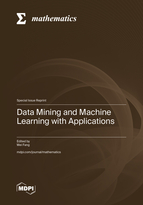Data Mining and Machine Learning with Applications
A special issue of Mathematics (ISSN 2227-7390). This special issue belongs to the section "Mathematics and Computer Science".
Deadline for manuscript submissions: closed (15 August 2023) | Viewed by 25444
Special Issue Editor
Interests: data mining; big data analytics; knowledge discovery; cloud computing
Special Issues, Collections and Topics in MDPI journals
Special Issue Information
Dear Colleagues,
With the emergence of big data and the advances made in computing services, artificial intelligence (AI) has attracted increasing attention around the world. The role of AI is becoming more and more important in our daily lives in applications such as machine learning, pattern recognition, computer vision, data mining, human-machine interfaces, information retrieval, and natural language processing. To this end, an increasing number of researchers and engineers are already or will be involved in the AI field.
This topic aims to bring together leading scientists in deep learning and related areas within artificial intelligence, data mining, and machine learning with applications. Papers using advanced mathematical methods and statistical approaches in these areas are particularly welcome for publication in this Special Issue.
Prof. Dr. Wei Fang
Guest Editor
Manuscript Submission Information
Manuscripts should be submitted online at www.mdpi.com by registering and logging in to this website. Once you are registered, click here to go to the submission form. Manuscripts can be submitted until the deadline. All submissions that pass pre-check are peer-reviewed. Accepted papers will be published continuously in the journal (as soon as accepted) and will be listed together on the special issue website. Research articles, review articles as well as short communications are invited. For planned papers, a title and short abstract (about 100 words) can be sent to the Editorial Office for announcement on this website.
Submitted manuscripts should not have been published previously, nor be under consideration for publication elsewhere (except conference proceedings papers). All manuscripts are thoroughly refereed through a single-blind peer-review process. A guide for authors and other relevant information for submission of manuscripts is available on the Instructions for Authors page. Mathematics is an international peer-reviewed open access semimonthly journal published by MDPI.
Please visit the Instructions for Authors page before submitting a manuscript. The Article Processing Charge (APC) for publication in this open access journal is 2600 CHF (Swiss Francs). Submitted papers should be well formatted and use good English. Authors may use MDPI's English editing service prior to publication or during author revisions.
Keywords
- Machine learning
- Data mining
- Statistical machine learning
- Statistical classification
- Statistical inference
- Bayesian methods
- Algorithms and architectures for big data searches, mining, and processing
- Deep learning
- Computer vision and image processing
- Evolutionary computation
- Knowledge discovery
- Industrial and medical applications
- Security applications
- Applications of unsupervised learning
- Industrial and medical applications






